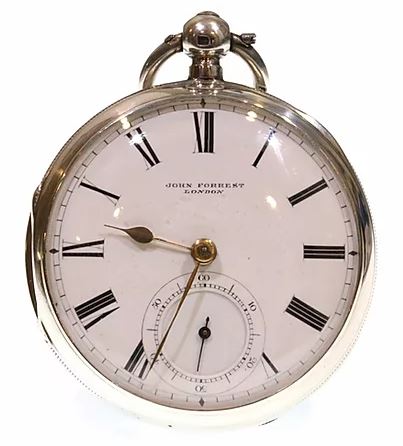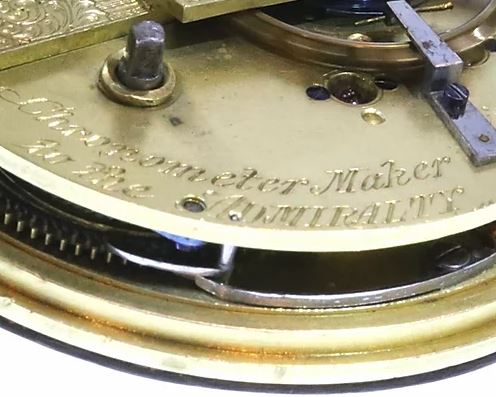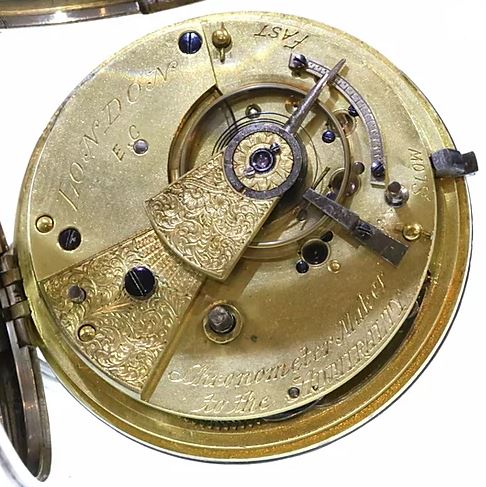Last updated on July 3, 2024
I am always on the lookout for a new antique watch to add to my collection. Normally I work from an ever-growing wish list. I enjoy researching watches as much as owning them. However, on some occasions, I come across an antique watch, which catches my interest but doesn’t meet my collection criteria. This post is about one such antique pocket watch, a John Forrest of London fusee pocket watch, 1891.
John Forrest of London
John Forrest ran a watchmaking business in Clerkenwell, London from 1850 until he died in 1871 (although some accounts suggest 1876). There are conflicting accounts of the quality of his work. Some suggest he was a mediocre watchmaker, encasing sub-standard movements in high-quality cases. Effectively, style rather than substance. However, there are some accounts suggesting the opposite, but the opinion of the majority is that the watches were not of a particularly high standard.
Whatever, John Forrest lacked in watchmaking ability, he more than made up for with his marketing prowess. On the dial of his watches, he printed John Forrest, London. On the movement plates, he stamped the words, John Forrest, chronometer maker to the Admiralty. This statement was totally untrue because John Forrest had never made a chronometer in his entire career.

Marine chronometers
In the 19th century, timekeeping was incredibly important to the Admiralty as a navigational tool. To determine an exact position on the Earth’s surface, it is necessary to know the latitude, longitude, and altitude. Obviously, at sea, the altitude can be ignored. Until the mid-1750s, accurate navigation at sea out of sight of land was an unsolved problem due to the difficulty in calculating longitude. Navigators could determine their latitude by measuring the sun’s angle at noon. However, to find their longitude they needed a time standard that would work aboard a ship. The purpose of a chronometer is to measure accurately the time at a known fixed location, for example, Greenwich Mean Time (GMT). Knowing GMT at local noon allows a navigator to use the time difference between the ship’s position and the Greenwich Meridian to determine the ship’s longitude.
Longitude prize
In 1714, the British government offered a longitude prize for a method of determining longitude at sea, with the awards ranging from £10,000 to £20,000 depending on accuracy. It took until 1761 for a chronometer made by John Harrison to meet their exacting standards. However, it wasn’t until several years later that Harrison received any of the prize money. In the years that followed to be considered a maker to the Admiralty, a watchmaker had to submit chronometers for trials at the Royal Observatory, Greenwich.
John Forrest was incapable of producing a chronometer and certainly not capable of passing a timekeeping trial. To get around this minor barrier, John Forrest would make a new watch and send it to the Admiralty as a free sample. In his mind, this justified his claim to be a maker to the Admiralty. As a marketing ploy, it worked very successfully and John Forrest sold many of his ‘maker to the Admiralty’ watches. Such was his success, that upon his death, there were a number of enterprising watchmakers willing to buy the rights to the John Forrest name.

Death
His trade equipment, including stock and goodwill, were all sold by his sister to Messrs. Carley & Co. They subsequently got into financial difficulties and later assigned their business to a Mr Read for the benefit of creditors who, in turn, sold the name and goodwill of the business of John Forrest to a Mr R. Thorneloe for £20. In the meantime, on 20 October 1883 and again on the 26th C. J. Hill of Coventry registered “Forrest, London‟ with fir tree symbol as a trademark and marketed watches with “John Forrest, Maker to the Admiralty‟ inscriptions. As a result of the registered trademark, Thornloe sold the name to Hill. In 1891 there was a court case in which C. J. Hill lost the right to continue to use the “Maker to the Admiralty” stamp on his watches.
The use of the name of John Forrest was used by a number of other watchmakers and manufacturers well into the 20th century. An example is the Lancashire Watch Company. There are a number of entries in the company ledgers for orders from retailers using the brand name John Forrest.
Reputation
The ‘maker to the Admiralty’ claims obviously enhanced the reputation of John Forrest to an unsuspecting public. As a result, John Forrest enjoyed considerable commercial success. It is understandable why watchmakers would try and capitalise on the name. Strictly, speaking, if you own an antique John Forrest pocket watch dated after 1871, it is effectively a fake. If you own a John Forrest watch dated before 1871, then it is the real deal. However, the standard is likely to be below that expected of the Admiralty.
This particular watch I saw on the RomanDial Watches website. It has a Chester date hallmark for 1891, which clearly places it after the death of John Forrest. It has a 13 jewel fusee movement with an English lever escapement. The watch is reported to be working within 1 minute’s accuracy per day.

The dial is in good condition, although the description reports a faint hairline crack. This is not visible in any of the photographs, so I doubt it would be noticeable by the naked eye. The mineral crystal is clear and free from chips and scratches. This is to be expected as RomanDial Watches fully service their watches and replace the mineral crystals. The sterling silver case measures 51mm x 18mm and weighs 114g. All of the hinges and catches are working correctly.
It’s a nice-looking watch with an interesting, but somewhat dubious history. Unfortunately, it is not one for my collection, but I thoroughly enjoyed researching the story behind John Forrest and his maker to the Admiralty claims.

I am Alexandra John’s great granddaughter. I would love one of his watches
Hi Alexandra, I imagine that it would have great sentimental value to you to own one. They occasionally come up for sale at one of my preferred suppliers. To ensure the watch is authentic just make sure that the watch is pre-1871. The John Forrest name was used long after he passed away. Thanks for commenting, Jason
Alexandra,
Good day to you.
Is there a way to contact you more private ?
I have two pre 1871 men’s watch and a Ladies watch. The man’s watch has been to the jewelers and recently cleaned and verified I left the Ladies watch to be cleaned and verified also and should be picking it up soon.
If you are still interested I would love for you to have these, if they were purchased at the same time ( pre 1871) and have stayed together all this time it would be quiet a nice surprise.
Aloha Jeff,
I am of the Greene family descendant of the late John Forrest. if there is no reply from Alexandra, may I look at your offer on the pre- 1871 watch.
Sincerely yours,
Randy A Griebenow
Papaikou, Hawai
lblgintree@gmail.com
How can I tell if my John Forrest watch is pre- 1871? The inscription on reverse is
John Forrest
54254
London
E.C
Wondering how I could get a key for the timepiece?
Thank you for any information
Hi Paul, if the watch case is made of silver or gold, it should be hallmarked. To find the hallmarks open the case back. This will be done by depressing the crown or by looking for a small lip near the crown that will allow you to open it. Inside you will see the keyhole for winding the watch. On the inside of the outer cover, you should see the hallmarks. You may need a magnifying glass to read them. One of the marks will be the date letter which you can use to determine the age of the watch. Here is a guide to reading British hallmarks. Pocket watch keys are available online. Simply search for “pocket watch keys”, they typically come in a set of 12 keys in different sizes, one of which will suit your watch. They cost approximately £5 a set. I hope this helps, thanks for commenting, Jason
Thanks for the info, but the date assayed is somewhat confusing. The top hallmark is 830, which I found to be 83 % silver, 17 % alloy. The 2nd hallmark is a lion with 3 legs on the ground. The 3rd down is 3 wheat sheaves with a sword in the middle, which would be Chester, beside it is a capital, (Peterson handwriting) F. As I read your manual, it looked like this is pre-1907. Is that correct? To the left of the above last 2, which were side by side, there is a 1. Below the town mark( wheat sheaves) and F, there is 254 and below that JH enclosed is a small box. I know my grandfather brought this watch with him when coming to the US from Glasgow sometime before 1920. Thanks for your help.
If I read correctly, the walking lion signifies that the piece is 92.5 % pure silver. What is the 830 at the very top mean?
Hi Paul,
I have been looking into this for weeks now and still cannot come up with a definitive answer. As you point out the Lion signifies Sterling silver (92.5% pure) and 830 represents 83% purity. The 830 standard was common in Scandinavian countries, such as Norway. My best guess is that this is a Sterling silver case made in Britain for export to the Scandinavian markets where the 830 symbol would be recognised. Sorry, I couldn’t be of more help, Jason
how do you move the hands on a John Forrest pocket watch please
Hi Graham, pocket watches are typically key-wound, key-set or crown-wound, key-set. Here is information on how to wind and set the time on antique pocket watches. Be very careful if your watch is set by opening the dial bezel and resetting via the arbor on the hands. If you accidentally bend the hands they can interlock and stop the watch. Use this page to decipher the British hallmarks, which will let you know if the watch was made by Forrest or a later imitator. Please let me know if you require any more information. Thanks, Jason
Hi, I was about to bid on a John Forrest today 19/3/23 for my collection. After reading your articles i have decided not to. Thank for a very interesting item..Regards Mike.
Hi Mike, I assume you discovered you were about to bid on a watch that dated to after Forrest died in 1871. If so, it was probably a wise move to pull out. Buying a non-original watch is not good from a value point of view. I hope the post was useful. Thanks, Jason